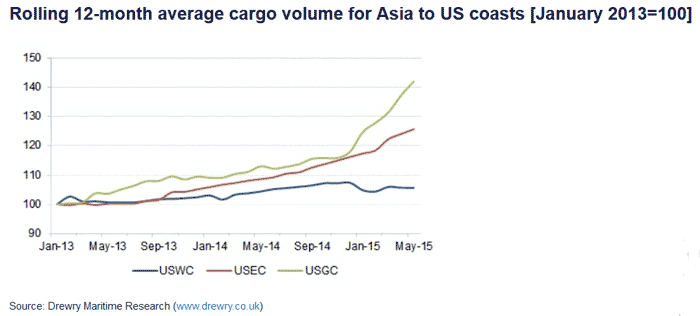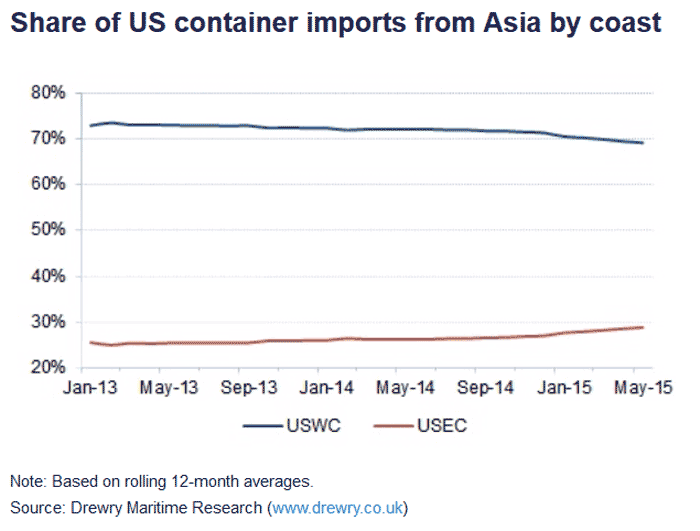From SCDigest's On-Target e-Magazine
- July 8, 2015 -
Global Supply Chain News: Asian Container Volumes Continue to Migrate to East Coast Ports Even before New Panama Canal Opens
East Coast Ports have Nearly Doubled Market Share Since 2000, Likely to See More Gains when Expanded Canal Comes On Line
SCDigest Editorial Staff
Even as the West Coast port turmoil, backlogs and delays fade from the scene, ocean container volumes from Asia continue to migrate from US West Coast Ports to the East, a trend sure to accelerate when the expanded Panama Canal opens next year.
SCDigest Says: |
 |
Drewry notes all that capacity being added from Asia to East Coast ports will likely drive cost to shippers down, as is already occurring even before this new capacity comes on-line. |
|
What Do You Say?
|
|
|
|
The analysts at Drewry Shipping say that since January 2013 traffic from Asia to US East Coast ports has grown by 26%, compared to just 6% growth in container traffic to West Coast ports, meaning the East Coast is rapidly gaining market share.
The fastest growth is actually being seen in container traffic from Asia to US Gulf Coast ports, with growth of just over 40% for the period, but it comes off a very low base and has barely shifted the Gulf Coast market share much beyond 2%.
Those trends are illustrated in the graphic below, which plots an index score based on January 2013 container volumes, using a rolling 12-month average in order to smooth out the monthly spikes that obfuscate the long-term trend, Drewry says.
As can be seen, the growth of East Coast volumes really began to lift above the West Coast in the fourth quarter of 2013, and took off a year later when the disruptions and problems relative to the labor strife at West Coast ports became major issues.
The West Coast still dominates Asian traffic, with about a 69% share, as shown in the graphic below. Still that continues to trend down from about a 73% share in early 2013. In 2000, West Coast ports held a commanding 84% share of container traffic from Asia. Since then, East Coast traffic has nearly doubled to a 29% share.
Meanwhile, the situation is even worse for West Coast ports when measured in terms of the share of the dollar value of goods imported in containers, which fell to 45% in May, down
from 51.5% a year ago, according to data released Tuesday by the US Census
Bureau.
Most of the East Coast's recent gains has come from greater use of Asia to US via Suez Canal services that are able to accommodate larger ships. But Drewry says that trend is now reversing, and Panama Canal loops are again gaining share as carriers prepare themselves for the expanded Panama Canal.


The expanded Canal is said to be about 90% complete, and scheduled to open next April. The expansion will enable the Canal to handle ships with as much as 13,000 TEU capacity, versus just 5000 TEU currently. While it will not be able to accommodate the massive current generation 18-20,000 TEU ships, it doesn't really matter because US East Coast ports cannot handle those giants vessels either.
Drewry notes that since the start of the year there have been six new services created for the Asia to US East Coast trade, with all but one of them routed via the Panama Canal. That includes a new route from 2M alliances carriers Maersk and MSC, which will use the Canal for the first time, with the wolrd's two largest lines having previously focused only on the Suez.
(Global Supply Chain Article Continued Below)
|